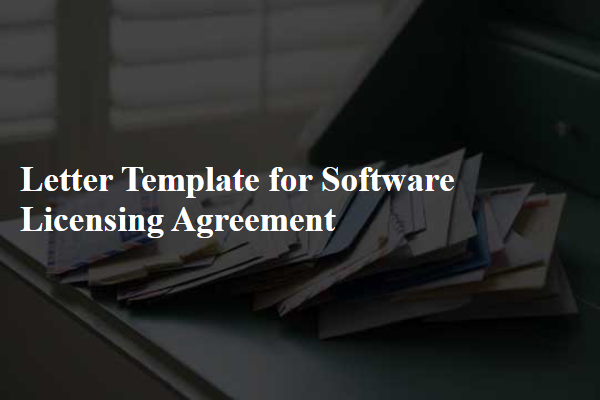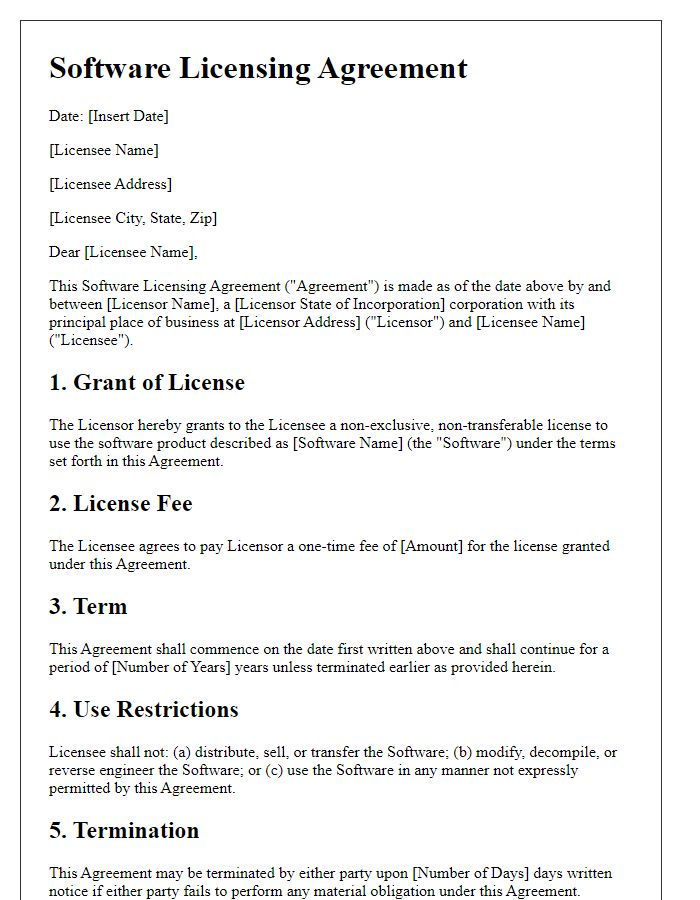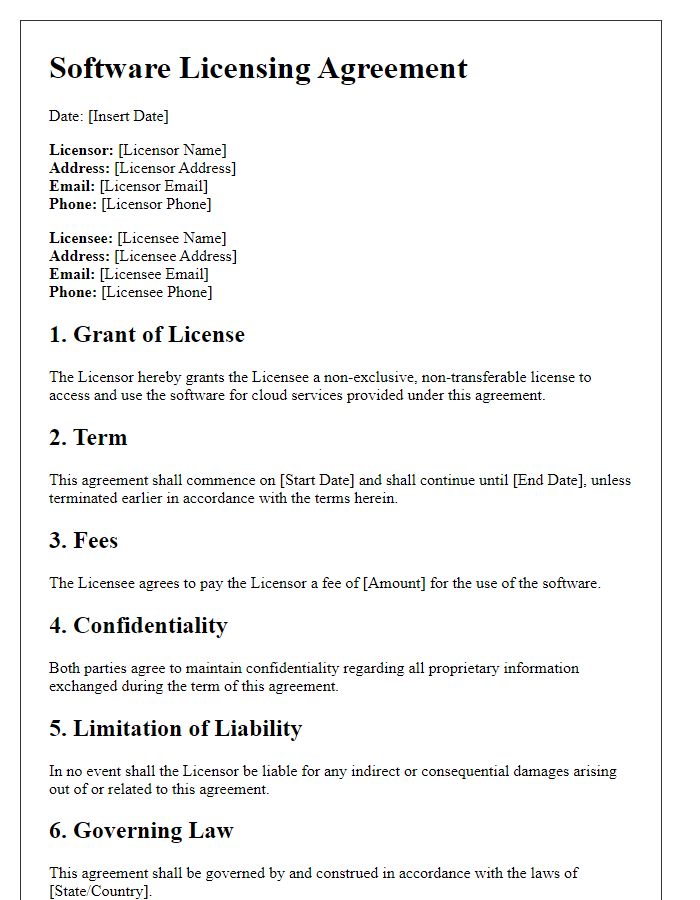Are you ready to dive into the world of software licensing agreements but unsure where to start? Crafting a clear and comprehensive agreement is essential for protecting your intellectual property and ensuring both parties understand their rights and responsibilities. This letter template will guide you through the essential components, from defining the scope of the license to outlining payment terms and termination conditions. Keep reading to discover how to create an effective software licensing agreement that suits your needs!

License Grant and Restrictions
A software licensing agreement outlines the terms under which a software company grants a license to its product, detailing restrictions and allowances regarding usage. The License Grant section typically specifies the scope of use for the licensed software, such as single-user, multi-user, or enterprise-level deployment, ensuring the licensee understands their rights and limitations. Restrictions often include prohibitions against reverse engineering (the process of deconstructing software to understand its architecture), distribution (sharing the software with unauthorized third parties), or modification (changing the software's code or functionality without permission), all critical for the protection of the proprietary rights of the software developer. These terms align with enforcement methods, such as audits to ensure compliance, and potential penalties for violations, safeguarding the intellectual property contained in the software.
Payment Terms and Conditions
Payment terms and conditions in a software licensing agreement define the financial obligations of the parties involved in the transaction. They typically include specifics such as the total licensing fee (e.g., $1,500 for a one-year term), payment schedule (e.g., upfront payment due upon signing), acceptable payment methods (e.g., credit card, bank transfer), and any late payment penalties (e.g., a 5% fee after 30 days of the due date). Additionally, the agreement may outline conditions for refunds, renewal terms, and price adjustments after the initial term, along with stipulations regarding taxes and other applicable charges that both parties must adhere to, ensuring clarity and compliance for future financial interactions.
Intellectual Property Rights
Intellectual Property Rights are crucial in software licensing agreements, protecting the proprietary nature of software products. These rights encompass trademarks, copyrights, and patents, preventing unauthorized use and distribution of source code and compiled software. Notably, software licenses often include clauses delineating the scope of use, duration of the agreement, and territorial restrictions. Specific licensing models, such as proprietary, open-source, or freeware, dictate how end-users can interact with the software. The enforcement of these rights is vital for software developers and companies, allowing them to maintain control over their innovations while ensuring compliance with licensing terms. Each jurisdiction, such as the United States or the European Union, may have distinct legal frameworks governing these rights, impacting how software is developed, shared, and protected.
Warranty and Liability Limitations
In software licensing agreements, warranty and liability limitations are crucial components. Warranty clauses typically specify the extent of the software developer's commitment to rectify defects, ensuring functionalities, and providing support within defined time frames, often ranging from 30 to 90 days post-purchase. Liability limitations delineate the scope of financial responsibility, frequently capping damages at the total amount paid for the software license or a predetermined figure, such as $10,000. These clauses aim to protect developers from unforeseen costs tied to software malfunctions or user misuse, acknowledging potential risks, such as data loss or security breaches, while outlining obligations under specific jurisdictions, which may vary greatly, such as compliance with the California Consumer Privacy Act (CCPA) or the General Data Protection Regulation (GDPR) in Europe.
Termination and Renewal Conditions
A software licensing agreement outlines specific terms regarding termination and renewal conditions which ensure clarity between the licensor (software creator) and licensee (end user). Termination conditions can include scenarios such as breach of contract, failure to make timely payments, or unauthorized use of software, lasting typically 30, 60, or 90 days based on severity. The agreement must also detail the renewal conditions, specifying if automatic renewal occurs annually or biannually unless notice of cancellation is provided. Licensing fees related to different versions of the software may vary; for instance, updates or premium features could require additional payments. Additionally, procedures for returning or destroying software upon termination need clear articulation to prevent any unauthorized access or usage.
Letter Template For Software Licensing Agreement Samples
Letter template of Software Licensing Agreement for Enterprise Solutions

Letter template of Software Licensing Agreement for Educational Institutions

Letter template of Software Licensing Agreement for Non-Profit Organizations











Comments